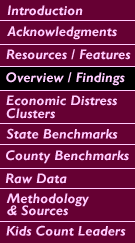

|
 |
 Copyright 1998 Oklahoma Institute for Child Advocacy, Inc. 420 NW 13th Street, Suite 101 Oklahoma City, Oklahoma 73103 Phone: 405-236-KIDS Fax: 405-236-KIDX |
Narrative A two-page pdf file (127K) with narrative and chart is also available. (You will need Acrobat Reader.) The chart shows the eight benchmark measurements and their comparison to 1997 data. On to Economic Distress Clusters Children make up over one- fourth (26.6%) of Oklahoma's population and the number continues to grow. Today, almost eight hundred sixty-seven thousand (866,950) children live, play and go to school in Oklahoma communities. Many of these children are in distress. The goal of the Oklahoma Institute for Child Advocacy (OICA) is to improve life for Oklahoma's children. The Oklahoma Kids Count Partnership, a project of OICA, uses key strategies to achieve this goal. First, Kids Count "counts kids," providing accurate and up-to-date data on the status of Oklahoma's children and youth. Second, Kids Count cultivates leadership on behalf of children and youth, giving voice to their needs at the local level. Third, Kids Count communicates the needs of children and youth, using extensive public awareness activities. The Oklahoma Kids Count Factbook uses benchmarks to profile the status of children and youth in our state. Benchmarks are quantifiable measures that, when taken together, help determine child, family and community well-being. The eight benchmarks in the Kids Count Factbook are low birthweight infants, infant mortality, births to teens, child abuse & neglect, child death, child poverty, high school dropouts, and juvenile violent crime arrests. This book, the fourth annual Oklahoma Kids Count Factbook, shows the interrelationship of these benchmarks and how they impact each other. From the established baselines, OICA is tracking progress in certain key areas over time. Progress is not just improving the statistics. Progress is using all of this information - and more - to make good decisions about state and community budgets and programs that affect children and youth. Effective programs and policies work together with strong communities and families to improve the benchmarks. It's not just about numbers; each number has a face, a family, and a future. The 1998 Oklahoma Kids Count Factbook reveals that half of the eight benchmarks (low birthweight infants, child abuse & neglect, child poverty and juvenile violent crime arrests) continued to worsen when compared to data from a decade or more ago. Low birthweight infants and child poverty worsened further and child abuse & neglect and juvenile violent crime arrests showed slight improvement during the most recent year(s). The other four benchmarks (infant mortality, births to teens, child death and high school dropouts) continued to improve over the comparable decade-old data, and maintained their slow improvement during the most recent year. (View pdf file (127K) with this narrative and chart illustrating the eight benchmarks.) Back to Top of Page |
  Web access launched March 24, 1998 |